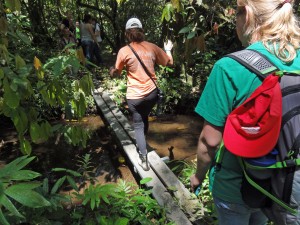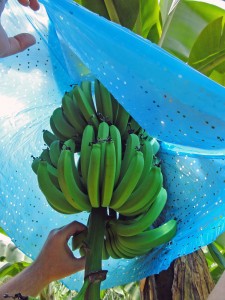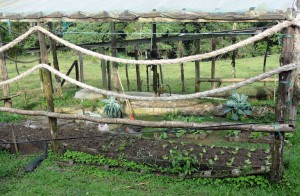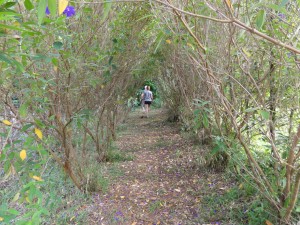
Our group with the Laureles farm family. From left to right: Becca, Leesha, Fernando, Lidia, Carla, me, and the Laureles grandson in sunglasses in front.
My preparations the night before paid off, as I slept really soundly and not worrying about bugs. The whole thing with the dogs must have bothered me more than I thought because I dreamed that I was walking by a busy street in back of the UNC campus (where I did my undergrad) and found two dogs in different places who had been hit by cars and were lying by the road with broken legs. In the dream I scooped them up and was taking them to get medical care when I woke up.
I got up before dawn, and three of us (Carla, Leesha, and me) went to watch the sun rise over the farm. Just as at the beach at Tortuguero, the sun didn’t come up in a ball like we are used to seeing at home. It just got light. Fernando’s cattle were mostly sitting down (which cattle here seem to do a lot) or grazing peacefully. Leesha tried to make friends with one of their horses in the pasture, but he was shy and didn’t want to get too close. On the way back we stopped by the howler monkey trees again. The monkeys had been very active just before dawn howling to greet it. They were still active getting their breakfast when we stopped by the trees. We probably watched them for a half hour. At first they hid, but after a bit a few came out where we could see them, including a mom with a baby on her back. She sat watching us for a long time, and I got a ton of pics.
Then we went back to the farm where we got to help Fernando milk the cow. That was fun – Leesha was a natural, and I got the hang of it but am glad I don’t have to do it every morning. Fernando put the calf into a separate enclosure while we got a bucket full of milk. When we were done, he let out the calf, who made a beeline for his mom. I’m glad they let the calf stay with the mom. The mother-offspring bond is the strongest in nature, and to talk the calf away so that we can take the milk does not seem right. It was enough to make me switch mainly to almond milk, though it’s hard to avoid dairy entirely. While we were milking the cow with Fernando, Lidia came out with a glass that we filled up straight from the cow. She then used that to make some of the very best pancakes I have ever eaten, which we had along with eggs, juice, and of course rice and beans.
<Optional thoughts about the book I was reading>
While the rest of the group walked for a swim at a river spot with difficult access, I got some reading done in This Changes Everything. Naomi Klein makes the case that climate change will require us to abandon unregulated free market capitalism to enact the collective solutions needed to address carbon emissions. She thinks it is a great opportunity to reshape human relations to be more just, equitable and fair, to enact protections for workers and poor people around the world.
It’s a compelling argument, but I’ve also read some interesting critiques. Basically the critiques say Klein was anti-capitalism before she started writing about climate change – she wrote about clothing factory workers in South America and about disaster opportunism, in which big companies use the opportunity of a disaster to make a windfall profit. The critiques think her current book is more of the same vein, and that she doesn’t give enough credit to some of the market solutions being proposed such as a price on carbon.
Klein says we need a mass social movement to force governments to take the steps needed to address climate change. I agree with that, but I think we need market solutions too. A carbon tax, preferably with the proceeds being returned equitably to everyone in the form of dividend checks or tax cuts as proposed by Citizens Climate Lobby, is a must. Klein thinks this idea is okay but not nearly enough. I think it’s just a start too, but it’s a vital one. We have to disincentivize fossil fuels and incentivize renewables if we want people to make the switch.
Klein seems to talk mostly about mass movements but decentralized control with communities taking charge of their own energy, transit and food systems. I would love to see that, and mass movements are important. That’s what stopped the Keystone pipeline, which is of huge symbolic value, and having participated with the Sierra Club in the People’s Climate March in New York City, I feel like the march helped provide immediacy and momentum to the UN talks that week. It was shortly after that when Obama announced the first-ever agreement with China to lower emissions. Of course none of this is enough and the work is not done, but you have to start somewhere.
This year will be huge for climate agreements leading up to the talks in Paris in December where everyone is hoping for the first time to get a binding agreement across all nations. That will be a tall order. Klein is right that social movements will make a huge difference in the climate debates, and she is right that control needs to come down to the local level.
I’m pleased to live in Columbus, which has a very ambitious green plan. But this leads to my critique of Klein’s focus on social movements. As important as they are, in the end it is governments, whether local state or national, that will decide if, when, and how we address climate change. This is why I’m studying public policy. I’m not exactly sure where this course of study will lead, but climate change is the most important issue not just in my lifetime but maybe in of all human civilization, and I want to be in a place where I can help address it.
<End of thoughts about the book and back to the trip>
So most of Friday afternoon was spent on the bus driving to the Villa Finca Tina ecolodge in the mountains, then to the Baldi hot springs. I’m pretty sure this will get changed up next year, since we didn’t make it to the hot springs until after 9 p.m. so had less than an hour. They were absolutely amazing though, as was the lodge which had several rescued orphan deer and even planted special grasses for the deer to eat.
In Ohio it is against the law to rescue orphan deer. I understand about wildlife rehabilitation needing to be licensed, but we should allow people who care – and most people do – to help animals that need help. Even if those orphans go to a sanctuary to live out their lives, that’s better than being killed just because they were unlucky enough to lose their mother. In one case, a police officer and his wife rescued an orphan deer whose mother had been hit by a car. When the authorities came and take it, the couple claimed the deer had escaped the day before and showed their torn screen door. In reality I’m thinking they probably found a sanctuary out of state to take the deer.
It’s a ways until retirement, but it liked the ecolodge area and hot springs so much, I would give serious consideration to retiring there. The community seemed to have a lot of natural healing practitioners, and as of now it’s affordable. I’ll have to come back with my husband and investigate this idea more thoroughly before making any decisions, but this is now a possibility on the list.























